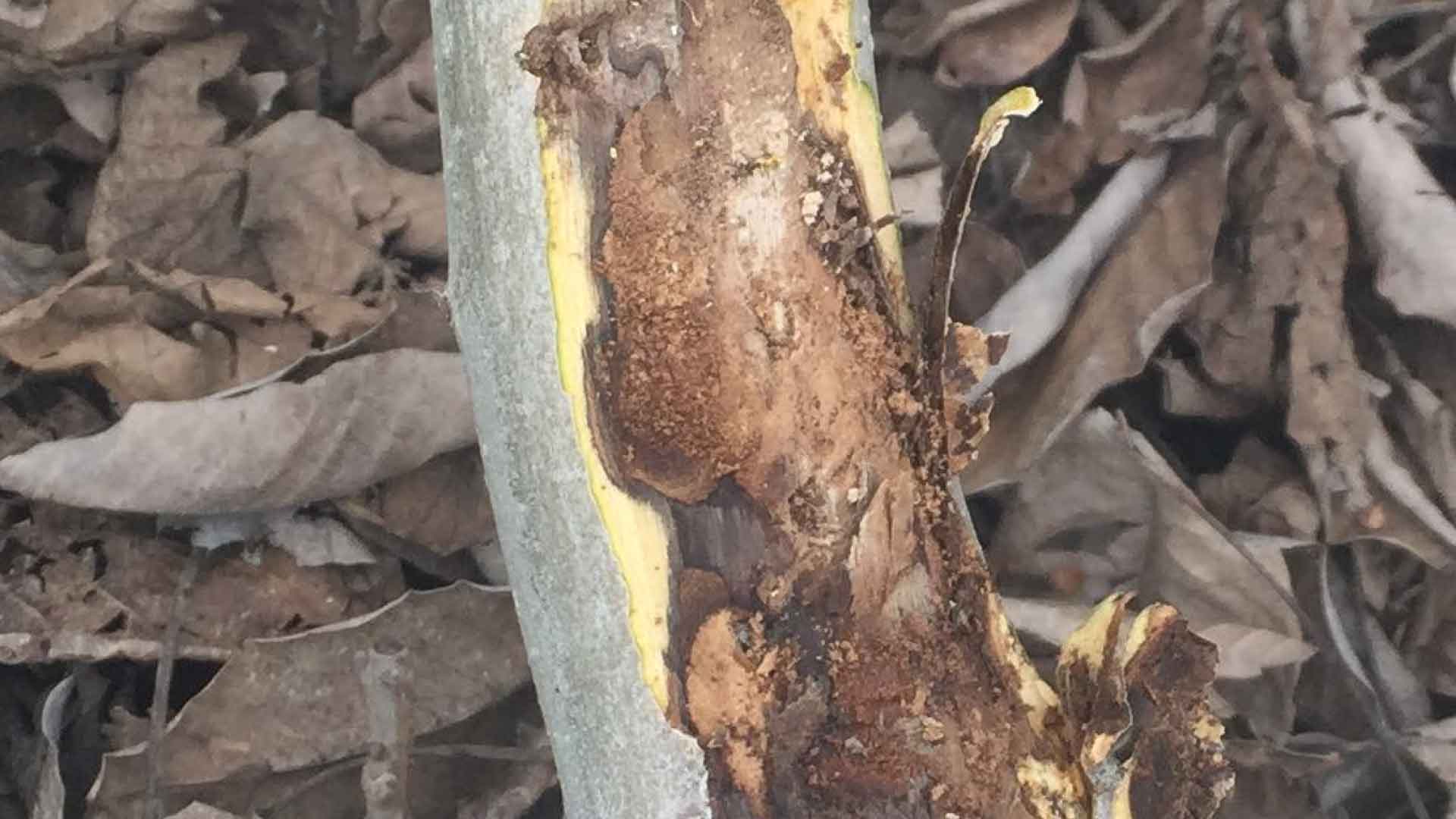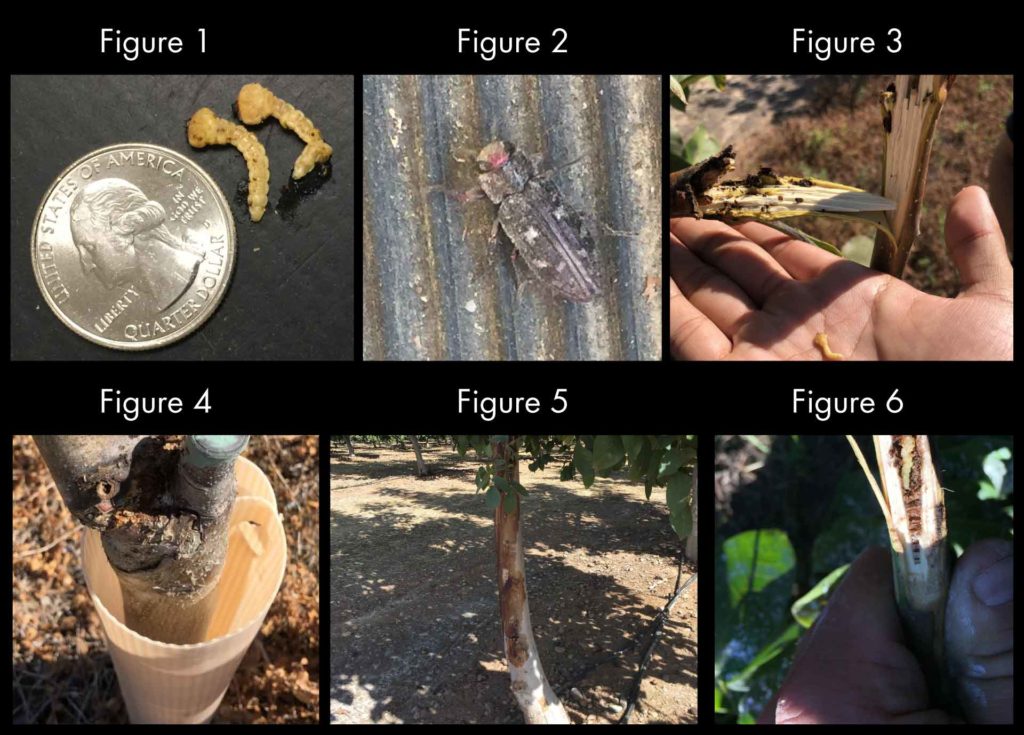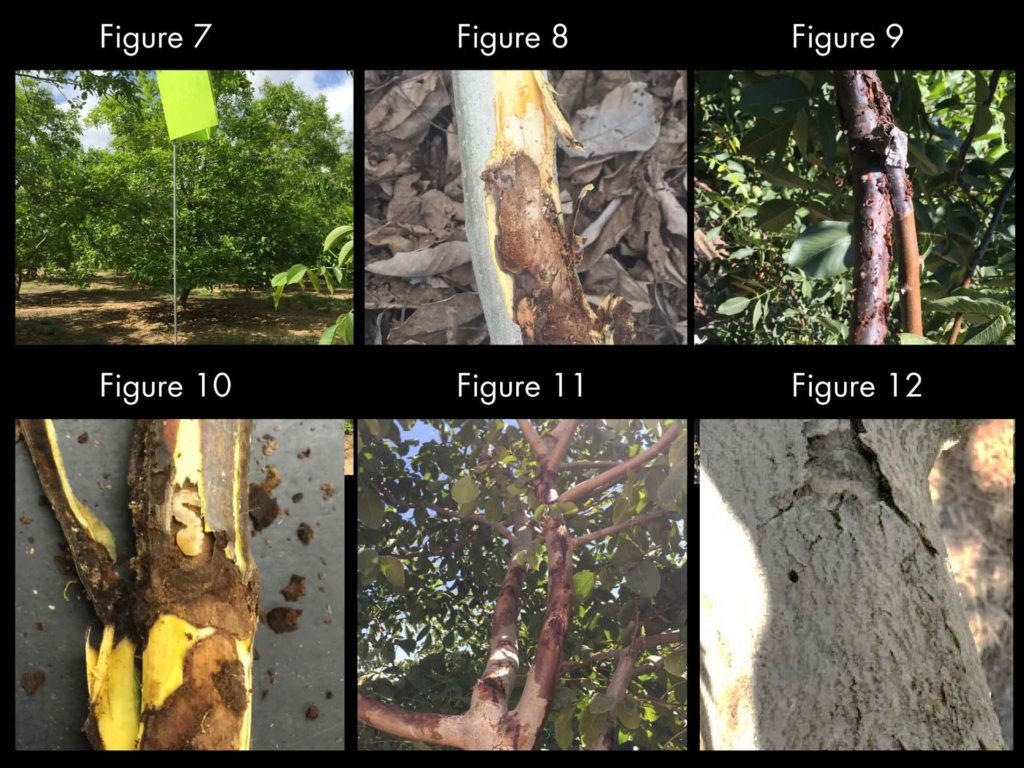Background and Pest Status
Flatheaded borer is a larval stage of one specialized group of beetles (Insect family-Buprestidae), which are glossy iridescent colors. The name ‘flatheaded’ comes from the enlarged and flattened shape just behind the head of the larval stage (Fig. 1) of the beetle (Fig. 2), and the flatheaded borer species that has become a major issue in walnuts is Pacific flatheaded borer (PFB), Chrysobothris mali, which is known to present in the western states such as Washington, Utah, Oregon, California. A similar type of borer species causing serious damage in various nurseries and other fruit and trees in the eastern part of the United States is called Appletree flatheaded borer, Chrysobothris femorata.
Although Pacific flatheaded borer has been an occasional pest of young fruit and nut crops in the past, in recent two years, this borer has become a widespread issue in several walnut orchards from young unbearing trees to mature and healthy trees. PFB has been reported as an issue in a big way in walnuts in the fall of 2018 when several growers and pest control advisers reported the unusually high instances of flagged branches, dead twigs, and even ‘canker-like’ symptoms in tree trunks in San Joaquin and Stanislaus counties. We visited more than ten walnut orchards with various degrees of damage caused by this borer in the region. In addition, we also received reports of the flatheaded borer attack in several walnut orchards from Sacramento and Southern San Joaquin Valleys as well. In the 2019 season, we have seen a high incidence of the borer infestation in walnut orchards especially young ones. In mid-September, I visited at least three walnut orchards that were under attack by the flatheaded borer. One of them is a one-year-old orchard, and the second orchard was a two-year-old. Both of these orchards had over 90 percent trees with flatheaded borer infestation in the trunk (Fig. 3-4). The third orchard was a six-year-old orchard in which PFB attacked various parts of the tree (twigs, branches, limbs, and trunk, Fig. 5). In general, based on two years of observations in various orchards, flatheaded borer infestation was found in both young (1-5 years) to mature (6-20 years) orchards irrespective of the walnut variety. There might be some differences in terms of susceptibility among common varieties (such as Howard, Chandler, Tulare), but none of them were found immune to the borer attack at least based on the field observation.
In many cases, growers were not aware of the borer attack on trees, which was not surprising as the flatheaded borer had never been a pest of the regular watchlist in the past. In general, the flatheaded borers are known to cause damage to weaker, wounded, and sunburn-susceptible parts of the tree. This is still true that these trees are more likely to attack by flatheaded borer; however, in our observation, the damage was not just limited to wounded and sunburn-damaged branches, and this trend of attacking healthy trees is very concerning. The damage within the orchard was observed randomly within the orchard and even within the tree ranging from the small twigs (pencil-size), branches (two-four inches diameter), limbs to tree trunks.
Biology and Ecology
Pacific flatheaded borer belongs to beetle family ‘Buprestidae,’ the members of which are also called “jewel beetles” or metallic-wood borers. There are over 15,000 known species of these beetles in the world today, and a majority of them bore into the stems, logs, leaves, and roots of various plants. Pacific flatheaded adults are ½ to ¾ inch long small-sized, with brown with gray markings on the wing covers, and have an oval head with the wedge-shaped body (Fig. 2). Keep in mind that this borer can attack forest, landscape, and various other types of trees and has a wide host range. At least 70 tree species of 21 plant families have been reported as hosts that include alder, birch, ash, ceanothus, oak, boxelder, mahogany, maple, poplar, sycamore, willow, apple, pear, beech, elm, cotoneaster, peach, plum, avocado, loquat, cherry, currant, fig, apricot, walnut.
Life Cycle and Seasonal Phenology
Pacific flatheaded females deposit ~100 eggs singly in the potentially weaker portion of the wood (i.e., sunburnt, freshly pruned, etc.), bark crevices or depressions through which freshly hatched larva bore into the bark, feed on the cambium layer of the wood initially, but can reach to the heartwood eventually (Fig 6). The larvae are cream-colored and legless. They construct pupal chambers and molt into the final instar (i.e., prepupal stage) for overwintering in the late Fall. Pupation occurs in the spring and early summer, and the adult emerges. There is one generation per year, but the life cycle may be longer (1-3 years) in cooler areas, as reported in some literature.
We did not have any information about the seasonal phenology of this insect in walnuts in California when we discovered the epidemics of this pest last year, but this year, with the funding support from the California Walnut Board, we did a small study in which we collected infested branches in the winter, and the beetles were reared out from that collection. Based on that preliminary, we found that the majority of the beetles were emerged in mid-June, with the emergence continue for two months, May-June. The emergence timing can vary from year to year based on potential factors such as variety, temperature, locations, drought conditions, etc., and we need more research to understand various factors that might influence the seasonal emergence and borer incidence in orchards.
Insect and Damage Symptoms Monitoring
Although literature suggested that adults may be seen on sunny sides of the tree trunk during the summer, we never spotted adult beetles in our field visits and observations. There have been precedents of using big-sized (2-feet long) purple or green sticky traps (Fig. 7) and to capture other buprestid adults such as invasive species- Emerald ash borer. However, these traps were never tested against Pacific flatheaded borer in the past. Since finding the optimal trap type is critical to study the emergence pattern of this beetle, we are now testing these traps for their potential use in walnut orchards. We used both green and purple sticky traps and purple funnel traps in the 2019 season, and we were able to capture Pacific flatheaded borer adults in all trap types based on preliminary information we have, and we will continue to explore options to optimize these traps for improved monitoring of this pest.
At this time, it is recommended for all walnut growers to pay a little close attention to walnut trees, and find out whether flatheaded borer is doing some damage in the background given the fact that flatheaded borer damage may not be obvious in the beginning years, as other various factors may produce similar types of external symptoms such as flagged branches, dead twig, etc.
The following are the symptoms that can be used to confirm the presence of flatheaded borer infestation in walnut orchards.
- Scout the orchard to detect dead and flagged branches infested by the flatheaded borer and look for external infestation signs (i.e., larval feeding wound, fresh or old insect frass, Fig. 8).
- Look for any visual wounds on the tree branches and limbs that are prone to sunburn or have pruning or any kinds of cracks or wounds (Fig. 9).
- For young trees, check the damage on the trunk, especially in the south or west side of the tree as these sides are preferred sides for egg-laying by females due to higher sunlight exposure and heat. Also, check the graft union and pruning wounds closely.
- Use a knife to peel the bark in a suspected branch and look for feeding channels packed with frass (sawdust-like insect waste) and cream-colored larva underneath the bark (Fig 10). Keep in mind that larvae tend to move into the heartwood in the late Fall for overwintering and harder to find. Larval finds may be easier during June-August when feeding occurs in the cambium layer just beneath the bark.
- Look for the brown color sap oozed out and spread on the bark surface of the infested part of the tree. (Fig. 11).
- Look for D-shaped exit holes of the beetle on infested walnut limbs (Fig 12).
Management
Pacific flatheaded borer infestation may be reduced by adopting cultural practices that encourage vigorous, healthy plants, although the borer seems to attack healthy trees as well.
- Young trees should be protected from sunburn by applying the white latex paint (1:1 paint and water ratio) or using mechanical covers over the trunk (e.g., trunk guard) as sunburnt tissue is more susceptible for borer attack.
- Orchard sanitation—the removal of the weakened, injured, dead, and flagged branches are highly recommended during the late fall and winter as the mature larvae overwinter in the infested wood and by chipping the infested branches, you are killing those larvae.
Unfortunately, there is no insecticide registered to target flatheaded borer in walnuts, in California and there is an urgent need to investigate potential insecticides, timing, residuals, target stage, etc. to manage this pest effectively.


















